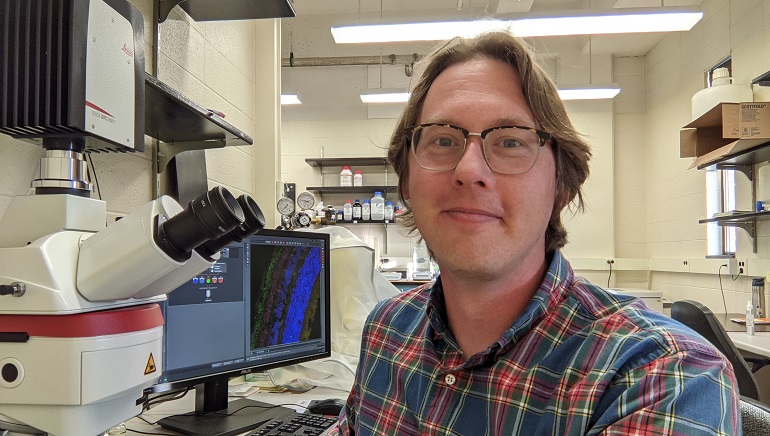
Assistant Professor Andrew Garrett, Ph.D., has secured funding up to $1.79 million over five years from the National Eye Institute of the National Institutes of Health to address the biology of neural circuit formation in the retina and how the nervous system organizes itself during development.
The research could lead to better understanding and development of therapeutic strategies for a variety of disorders, including major depression, dyslexia and schizophrenia.
“We will specifically learn how an important and diverse family of molecules – the gamma-Pcdhs – helps developing neurons achieve their correct shape, allowing them to find their appropriate synaptic partners,” he said.
Dr. Garrett joined the Wayne State University School of Medicine in 2018, and holds a joint appointment in the departments of Pharmacology, and of Ophthalmology, Visual and Anatomical Sciences.
He is the principal investigator of “Mechanisms of Cell Adhesion Molecular Function in Retinal Development,” his first major grant as faculty, focused on a diverse set of cell-surface molecules called gamma-protocadherins (gamma-Pcdhs). There are 22 members of this family, all encoded by a single gene cluster.
“Through mixing and matching, with each other and with members of two other adjacent clusters, the gamma-Pcdhs can make many thousands of distinct recognition complexes that mediate important cell-cell recognition events that facilitate correct network formation,” Dr. Garrett said.
In humans, these genes have been found to be disrupted or dysregulated in neurodevelopmental disorders.
“We are focused on the neuronal circuits in the retina, where the gamma-Pcdhs have two crucial functions: They promote self-avoidance, which lets individual neurons branch and spread out their processes to connect with synaptic partners, and they promote neuronal survival. We have found that this survival function requires one specific family member called Γ-C4, while we hypothesize that the self-avoidance function requires diverse family members for normal organization,” he added.
The experiments will test how much diversity is required for self-avoidance, and will identify molecular mechanisms by which gamma-Pcdhs promote self-avoidance and by which gamma-C4 promotes neuronal survival.
Dr. Garrett’s lab researches cell-surface molecules called cell adhesion molecules, including the gamma-Pcdhs, and how they mediate recognition events during neural circuit formation, specifically molecules involved in neuronal self-avoidance.
The research team includes Associate Professor of Ophthalmology, Visual and Anatomical Sciences Tomomi Ichinose, M.D., Ph.D., as co-investigator and Pharmacology graduate student Cathy McLeod.
The grant number for this National Institutes of Health study is EY031690.